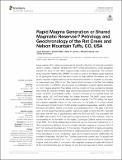Files in this item
Rapid magma generation or shared magmatic reservoir? Petrology and geochronology of the Rat Creek and Nelson Mountain Tuffs, CO, USA
Item metadata
| dc.contributor.author | Sliwinski, Jakub | |
| dc.contributor.author | Farsky, David | |
| dc.contributor.author | Lipman, Peter W. | |
| dc.contributor.author | Guillong, Marcel | |
| dc.contributor.author | Bachmann, Olivier | |
| dc.date.accessioned | 2021-07-20T11:30:01Z | |
| dc.date.available | 2021-07-20T11:30:01Z | |
| dc.date.issued | 2019-10-25 | |
| dc.identifier | 274371818 | |
| dc.identifier | 2071bdb8-eaa0-4a04-9bf9-ca7cc37bb7a8 | |
| dc.identifier | 85075555726 | |
| dc.identifier.citation | Sliwinski , J , Farsky , D , Lipman , P W , Guillong , M & Bachmann , O 2019 , ' Rapid magma generation or shared magmatic reservoir? Petrology and geochronology of the Rat Creek and Nelson Mountain Tuffs, CO, USA ' , Frontiers in Earth Science , vol. 7 , 271 . https://doi.org/10.3389/feart.2019.00271 | en |
| dc.identifier.issn | 2296-6463 | |
| dc.identifier.other | ORCID: /0000-0003-3069-9978/work/105007322 | |
| dc.identifier.uri | https://hdl.handle.net/10023/23608 | |
| dc.description | This study was supported by the ETH Research Grant ETH-34 15-2 (JS). | en |
| dc.description.abstract | Large-volume silicic volcanism poses global hazards in the form of proximal pyroclastic density currents, distal ash fall and short-term climate perturbations, which altogether warrant the study of how silicic magma bodies evolve and assemble. The southern rocky mountain volcanic field (SRMVF) is home to some of the largest super-eruptions in the geological record, and has been studied to help address the debate over how quickly eruptible magma batches can be assembled–whether in decades to centuries, or more slowly over 100’s of kyr. The present study focuses on the San Luis caldera complex within the SRMVF, and discusses the paradigms of rapid magma generation vs. rapid magma assembly. The caldera complex consists of three overlapping calderas that overlie the sources of three large-volume mid-Cenozoic ignimbrites: first, the Rat Creek Tuff (RCT; zoned dacite-rhyolite, 150 km3), followed by the Cebolla Creek Tuff (mafic dacite, 250 km3) and finally, the Nelson Mountain Tuff (NMT; zoned dacite-rhyolite, 500 km3), which are all indistinguishable in age by 40Ar/39Ar dating. We argue for a shared magmatic history for the three units on the basis of (1) similar mineral trace element compositions in the first and last eruptions (plagioclase, sanidine, biotite, pyroxene, amphibole, titanite, and zircon), (2) overlapping zircon U-Pb ages in all three units, and (3) similar thermal rejuvenation signatures visible in biotite (low-Mn, high-Ba) and zircon (low-Hf, low-U) geochemistry within the RCT and NMT. It is postulated that the NMT was sourced from a pre-existing magma reservoir to the northeast, which is corroborated by the formation of the nearby Cochetopa Caldera during the eruption of the NMT. The inferred lateral magma transport has two important implications: (1) it demonstrates long-distance transport of highly viscosity magmas at volumes (100’s of km3) not previously recorded, and (2) the sourcing of magma from a nearby pre-existing magma reservoir greatly reduces the rate of magma generation necessary to explain the close coincidence of three overlapping, large-volume magma systems. Additionally, the concept of magmatic “flux” (km3 kyr−1) is discussed in this context, and it is argued that an area-normalized flux (km3 kyr–1 km−2) provides a more useful number for measuring magma production rates: it is expected that magmatic volumes will scale with footprint of the thermal anomaly, and not taking this into account may lead to errant volumetric flux (km3 kyr−1) estimates. Meanwhile, area-normalized flux estimates in a given area are similar between units, consistent with evolution in a relatively constant thermal regime. Such estimates also demonstrate similar fluxes for ∼cogenetic volcanic and plutonic units. | |
| dc.format.extent | 1811672 | |
| dc.language.iso | eng | |
| dc.relation.ispartof | Frontiers in Earth Science | en |
| dc.subject | Biotite chemistry | en |
| dc.subject | LA-ICP-MS | en |
| dc.subject | Large silicic magma bodies | en |
| dc.subject | Magma flux | en |
| dc.subject | Magma rejuvenation | en |
| dc.subject | Mineral chemistry | en |
| dc.subject | Super eruption | en |
| dc.subject | Zircon geochronology | en |
| dc.subject | GE Environmental Sciences | en |
| dc.subject | Earth and Planetary Sciences(all) | en |
| dc.subject | DAS | en |
| dc.subject | SDG 13 - Climate Action | en |
| dc.subject | MCP | en |
| dc.subject.lcc | GE | en |
| dc.title | Rapid magma generation or shared magmatic reservoir? Petrology and geochronology of the Rat Creek and Nelson Mountain Tuffs, CO, USA | en |
| dc.type | Journal article | en |
| dc.contributor.institution | University of St Andrews. School of Earth & Environmental Sciences | en |
| dc.identifier.doi | 10.3389/feart.2019.00271 | |
| dc.description.status | Peer reviewed | en |
This item appears in the following Collection(s)
Items in the St Andrews Research Repository are protected by copyright, with all rights reserved, unless otherwise indicated.

